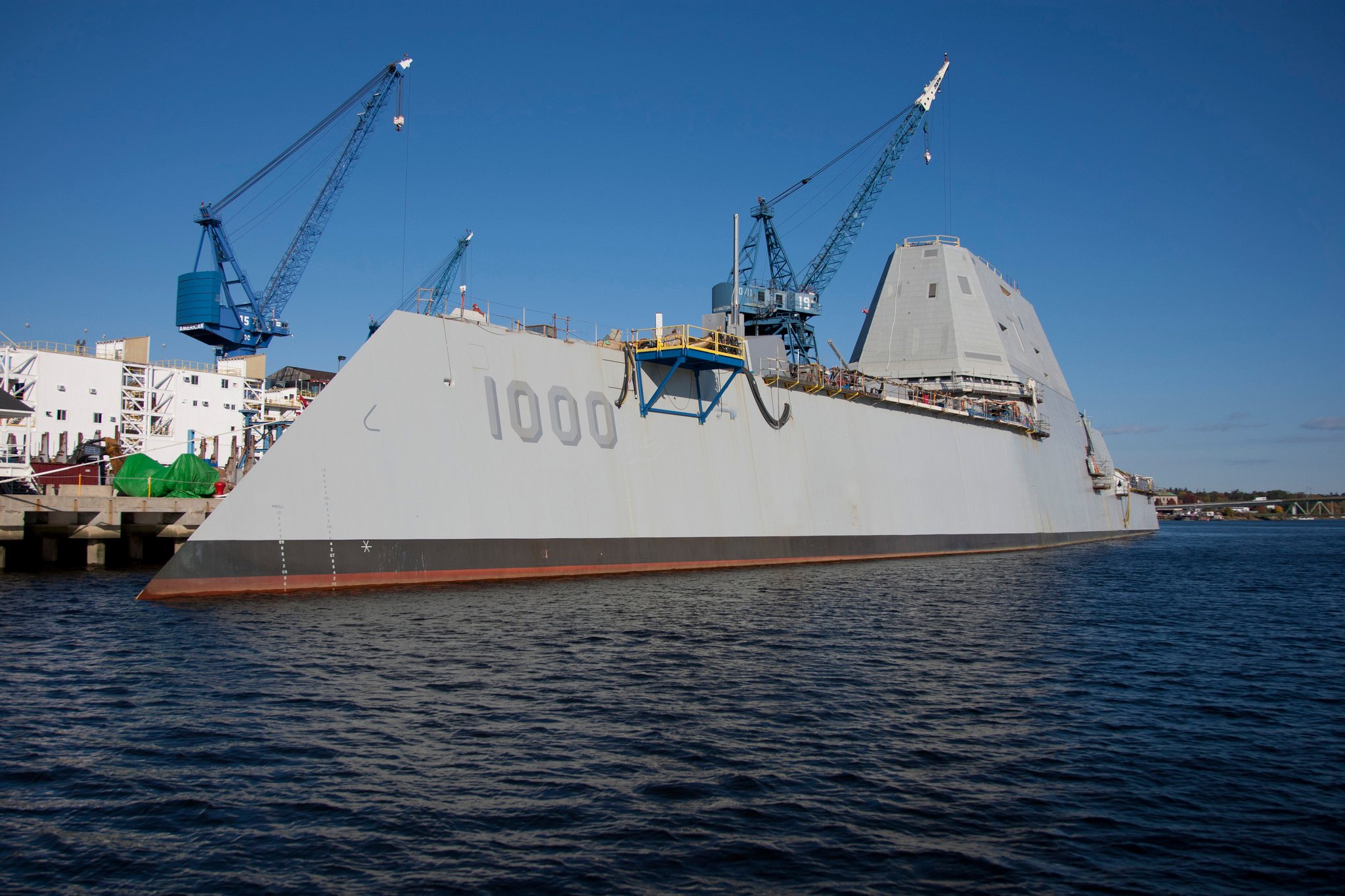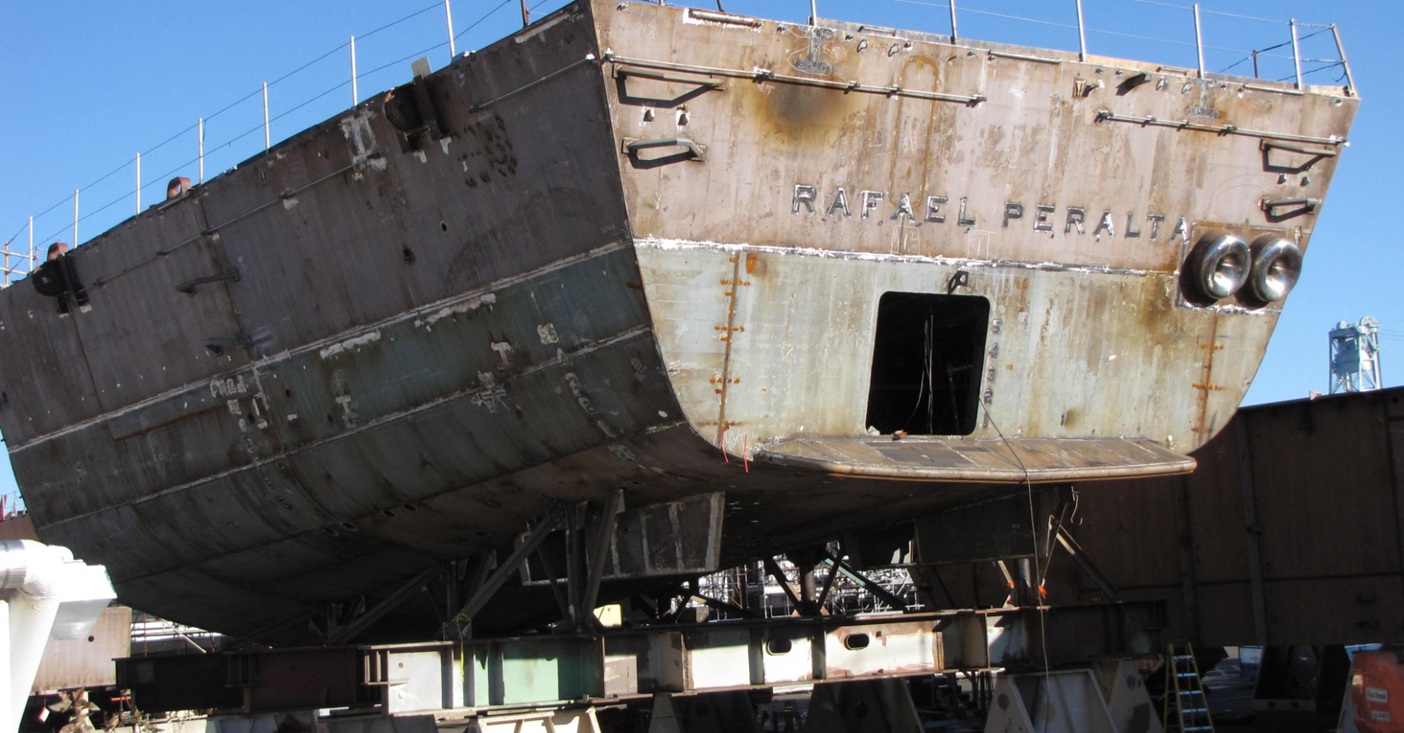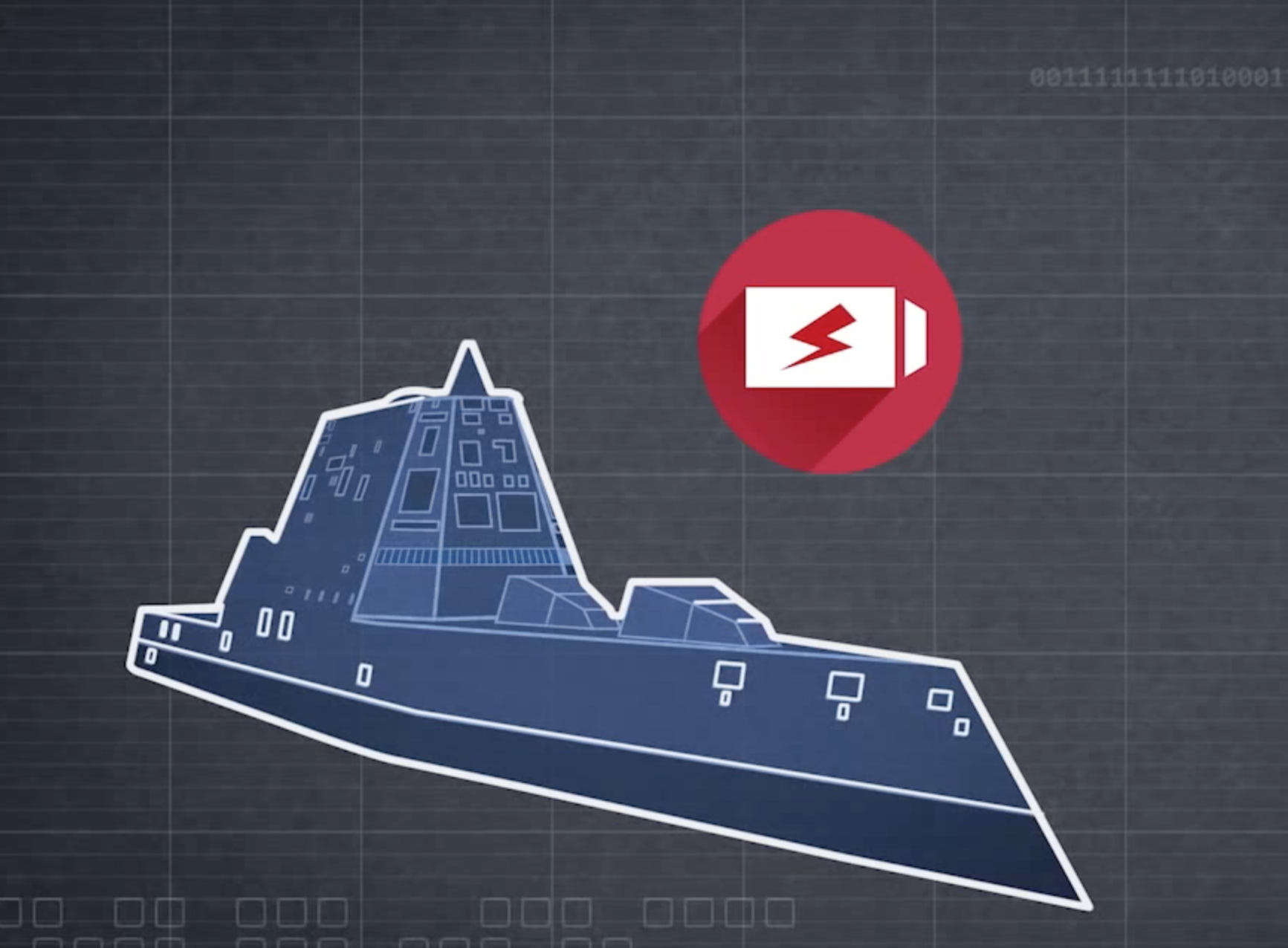
Delays in the construction of the first two of three next-generation Zumwalt-class (DDG-1000) guided missile destroyers at the General Dynamics Bath Iron Works shipyard are partially to blame for slowing work on two Arleigh Burke (DDG-51) destroyers being built at the Maine yard, USNI News has learned.
Several sources told USNI News that due to myriad reasons — including the size of the yard, the composition of the workforce at BIW and continued setbacks in the delivery of the first two next-generation Zumwalts — production of the future Burkes Rafael Peralta (DDG-115) and Thomas Hudner (DDG-116) have been delayed by several months.
USNI News understands the delivery schedule of Peralta has been pushed back seven months, while Hudner has been delayed five.
It’s unclear exactly how much the $22.1 billion Zumwalt program production is responsible for the delays in building the two Arleigh Burke ships, but several sources pointed to an electrician shortage on the yard as a major bottleneck. The three Zumwalts are being built with a revolutionary new integrated power system (IPS) for which the Navy is undertaking a rigorous testing program alongside its installation.
Neither the Navy nor BIW specifically addressed the Burke delays at the Maine yard when contacted by USNI News.
However, both issued statements to USNI News that pledged a commitment to increased efficiency in the construction of both the DDG-1000 and DDG-51 lines.
As of Tuesday, Zumwalt was “approximately 96 percent complete with her production and testing in support of delivery by Bath Iron Works,” the Navy said, adding the ship would begin pier-side trials in November and get under way in December. “Schedules for follow ships of the Zumwalt-class—Michael Monsoor (DDG-1001) and Lyndon B. Johnson (DDG-1002)—are likewise under evaluation.”
According to a Navy estimate in January, Johnson was 28 percent complete.
News of the bottleneck in Burke production comes at a bad time for the yard, as management is scrambling to improve overall efficiency for future destroyer work and a bid for a 25-ship, $10.5 billion contract for the U.S. Coast Guard’s new class of Offshore Patrol Cutters.
BIW’S Rising Costs

The two ships — Peralta and Hudner — were part of the Navy’s restart of the DDG-51 line announced in 2009 by then-Secretary of Defense Bob Gates following the cancellation of the service’s proposed next-generation cruiser (CG(X)) and the truncation of the DDG-1000 line to three ships.
In a series of deals between the Navy, BIW and its DDG-51 rival, Huntington Ingalls Industries (HII) Ingalls shipyard in Pascagoula, Miss., Bath was given the task of building the Zumwalt class following the reduction in the line.
“The agreement to have all three DDG-1000s built at BIW was a condition that Secretary of Defense Robert Gates set forth in an April 6, 2009, news conference on the FY2010 defense budget for his support for continuing with the construction of all three DDG-1000s (rather than proposing the cancellation of the second and third),” reads a June Congressional Research Service report on U.S. destroyer production.
While long-lead production work for the Zumwalts began at BIW, the yard won the contracts for the pair of Arleigh Burkes in 2011 when the yard soundly bested Ingalls in a split competition for the three Burke restarts. BIW offered a price-per-hull of $679.6 million versus a bid of $697.6 million from the Pascagoula yard.
Two years later, when the Navy awarded a $6.1 billion multi-year shipbuilding deal for nine Burkes, HII was the clear victor.
Not only did HII come in with the lowest bid per hull for the June 2013 award – $666.2 million per hull for five ships – BIW’s costs increased by $30.9 million, to $710.8 million per hull for four ships. BIW later was given a fifth destroyer contract in a subsequent award.
Since the loss in the 2013 multi-year, BIW has made attempts to increase the efficiency of the workforce — a key management initiative — to make the General Dynamics yard more competitive with its HII competitor.
“In order to improve our competitive position to win future work, BIW must reduce the cost of building ships in Bath, Maine, to a level the Navy can afford and at a price which is lower than our Mississippi competitors,” BIW officials said earlier this year, according to a May report in The Bangor Daily News.
In November 2013 General Dynamics placed NASSCO president Fred Harris — responsible for turning the beleaguered Lewis and Clark–class cargo ship (T-AKE) from one of the service’s worst performing shipbuilding programs into one of the best — in charge of BIW.
Harris spearheaded a series of workforce efficiency drives that have sparked conflicts between unions and management at BIW.
In particular, the lack of qualified electricians at BIW to work on both the Burkes and the Zumwalts has been a bottleneck in both lines, several sources confirmed to USNI News.
A proposal to import electricians from other General Dynamics shipyards – Electric Boat in Groton, Conn., and NASSCO in San Diego, Calif. – was met with intense resistance by the local unions.
“We don’t know if you realize it, but we’re not used to people coming into our yard,” Local S6 machinist union president Jay Wadleigh told The Bangor Daily News in March.
The Heart of the Zumwalt

Both the promise of the 16,000-ton Zumwalt-class and its ongoing delays are tied to its unique power scheme—the Navy’s new integrated power system (IPS).
Unlike the Burkes’ direct mechanical connection to its props from its gas turbine engines, the Zumwalts’ IPS creates a ship-wide power grid that not only powers the electric advance induction motors (AIM) that move the ship, but all of the ship’s other systems.
The twin Rolls-Royce MT-30 gas turbines and the two smaller Rolls-Royce RR450 gas turbines of the IPS provide a combined maximum of almost 80 megawatts of power—enough electricity to light a small town.
IPS is the Navy’s most recent and best expression of an electric ship concept—removing direct mechanical connections from the ship’s prime movers to its drive train and using the output to power electric motors that would drive the vessels through the water.
The Navy tried the concept in experimental U.S. nuclear attack submarines in the 1960s and 1970s, but shelved the effort because the output of contemporary electric motors did not propel the attack boats quickly enough.
Improved electric-motor technology in the past 20 years gave the electric ship effort new life and thus was made the centerpiece of the new Zumwalt class.
(An electric ship concept is also in development for the Navy’s $100-billion Ohio-class Replacement Program).
An electric configuration gives commanders many more options to route ship’s power to other systems. The IPS on Zumwalt also gives weapons and sensor makers more power margin to design new systems for the platform.
For example, Naval Sea Systems Command (NAVSEA) is considering installing a high-powered electromagnetic railgun on board the third Zumwalt— Lyndon B. Johnson (DDG-1002).
With the first Zumwalt, the Navy has elected to undertake a thorough testing program with the IPS to guarantee the health of the system before delivery—which led to a delay announced in March. The Navy pointed to the complexity of installing the IPS systems.
“The schedule delay is due primarily to the challenges encountered with completing installation, integration and testing of the highly unique, leading-edge technology designed into this first-of-class warship,” Cmdr. Thurraya Kent, acquisition spokeswoman for the Navy’s acquisition arm, said in a March statement.
In its Tuesday statement to USNI News, the Navy reiterated the importance of the testing regime for first-in-class Zumwalt.
“In view of the highly complex ship systems that underpin Zumwalt’s unique warfighting capabilities, the Navy and shipbuilder are executing the test program for this first of class ship with extreme rigor to ensure the highest standards of quality and completeness when the ship sails,” Kent said in a written statement. “Our current forecast, based on latest test program trends, is that Zumwalt will commence Dock Trials in November, in preparation for the ship’s first underway trial period in December.”
For its part, BIW said it was working with the service.
“BIW continues to work hard on the complex phase of test and activation, alongside the Navy and other navy contractors,” read a statement provided to USNI News.
The following are the complete written statements provided by the Navy and Bath Iron Works in response to questions from USNI News on how delays in the Zumwalt-class were affecting the Arleigh Burke line at BIW.
NAVY:
Zumwalt is approximately 96 percent complete with her production and testing in support of delivery by Bath Iron Works. With limited exceptions, the current forecast is for production to complete by September 2015. The shipboard test program, which is approximately 65 percent complete, comprises the preponderance of remaining effort in support of sea trials and ship delivery. In view of the highly complex ship systems that underpin ZUMWALT’s unique warfighting capabilities, the Navy and shipbuilder are executing the test program for this first of class ship with extreme rigor to ensure the highest standards of quality and completeness when the ship sails. Our current forecast, based on latest test program trends, is that Zumwalt will commence Dock Trials in November, in preparation for the ship’s first underway trial period in December. Schedules for follow ships of the ZUMWALT class, MICHAEL MONSOOR (DDG 1001) and LYNDON B. JOHNSON (DDG 1002), are likewise under evaluation. The Navy is working closely with the shipbuilder to ensure that lessons learned in the course of building and testing the first of class are being fully leveraged to improve performance on these follow ships. As we work to overcome schedule issues on this new ship program, we will maintain our priority on quality and efficiency in order to deliver both destroyer classes under construction at Bath Iron Works, DDG 1000 and DDG 51, in the most cost effective manner possible.
BIW:
DDG 1000 is the first ship of its class and incorporates many cutting edge technologies, integrating them together for the first time. BIW continues to work hard on the complex phase of test and activation, alongside the Navy and other navy contractors. We are fully under way on the restarted DDG 51 program, with two ships well into construction and a third in early stages. We continue to work with the Navy to manage risk across all our programs, control costs and balance BIW’s workload so we can deliver ships to the fleet as efficiently as possible.





